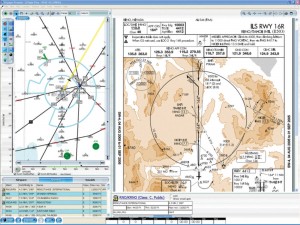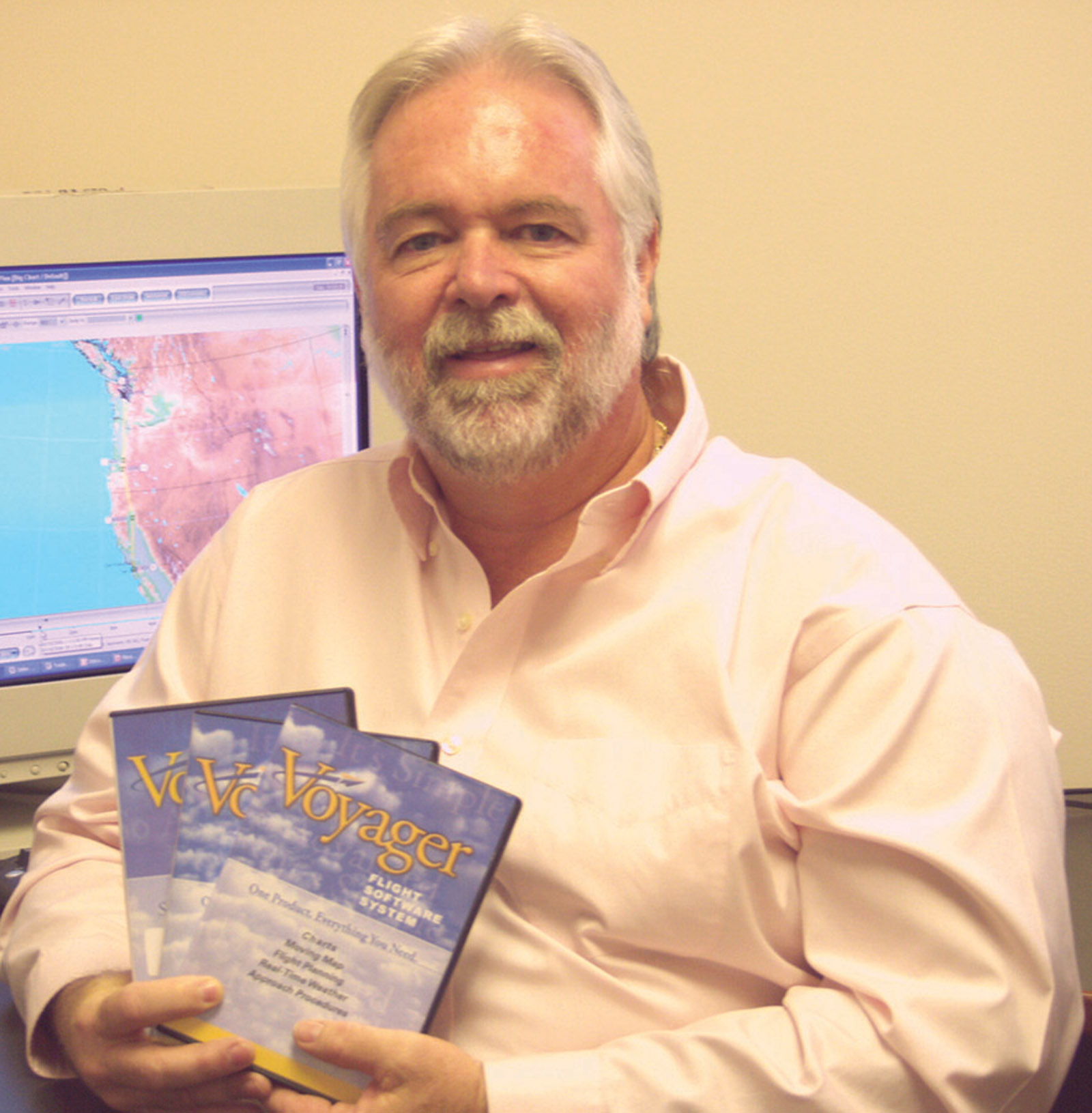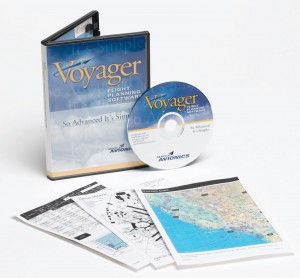By Terry Stephens

Jim Smith, Seattle Avionics national sales manager, said the company’s Voyager flight planning software is gaining national attention.
In 2003, Seattle Avionics Software Inc. tossed its sophisticated Voyager program into the crowded arena of flight planning software. The company was ready to compete in a market dominated by Jeppesen (owned by the Boeing Company) and several other creators of electronic flight bag products.
More electronic flight planning programs exist now than ever before, each more polished and complex than the predecessors. Seattle Avionics’ series of Voyager software packages have gotten better, too. Now that more than 3,000 pilots are using the program, representing quite a substantial foothold in the global market, Voyager’s fast performance and variety of options is attracting national attention.
Eclipse Aviation chose Voyager as its flight planning partner for the JetComplete program offered to pilots of high-performance aircraft. Shortly after that, Seattle Avionics, based in Bothell, Wash., forged marketing partnerships with King Schools, the world’s leading producer of aviation training videos and computer software; AvShop, an Internet marketer of aviation products; and Hilton Software, a leader in PDA aviation software for general aviation, commercial and military pilots.
Voyager’s latest boost to prominence in the crowded market came in August, when Aviation Consumer.com, an independent online source for impartial, detailed evaluations of aircraft, avionics and aviation products, surprised Seattle Avionics with an unsolicited analysis of the software. Voyager was “easily the top choice” in head-to-head comparisons with its competitors. Reviewing each aspect of the product, Aviation Consumer declared “the program’s capabilities leave competitors in the dust” and described it as “the most sophisticated and feature-rich planner ever.”
“With the advent of basic FreeFlight and free 10-day trials for all components, it really blows away its competition,” Aviation Consumer further stated.
“There’s nothing but blue sky ahead of us,” said Jim Smith, Seattle Avionics’ national sales manager. “The market has been aware of us for only the past year, but with boosts like this, and more promotion, my plan is to at least double our sales during the coming year.”
Smith sees a whole new plateau of market awareness and sales for the software. A new, expanded 4.0 version of Voyager will be out this fall. Each of its distinctive add-on components is now available online.
The team
Smith believes that the company’s love and understanding of flying has a lot to do with the success of its products. Seattle Avionics is made up of a group of pilots and programmers who looked at products on the market and decided “there had to be a better way to produce aviation flight software to make flying easier and more fun.”

A Voyager screenshot shows an aircraft’s planned route on the left and airport information on the right. Information also includes altitude, fuel availability and runway layouts.
One of the two company founders, CEO Steve Podradchik, began thinking about flight software programs while earning his private pilot’s license in 1999, making cross-country trips with cumbersome software. Unlike most pilots, he had the background to do something about it.
The former manager at Microsoft founded Marketwave Corp., a leading website traffic analysis firm, and served as CEO. Marketwave was sold to Accrue Software in 1999 for around $80 million. Podradchik also founded Medio Multimedia in Seattle. Along the way, he picked up a finance and marketing degree at Wharton School of Business.
John Rutter, cofounder and president, has been active in general aviation for a decade. He flies a 1996 Beech A-36 and belongs to aviation organizations including the Aircraft Owners and Pilots Association, Experimental Aircraft Association and Washington Pilots Association. His interest in aviation began when he was only 9, flying in his uncle’s Cessna 172 in Colorado.
After eight years as a sales manager with Microsoft, Rutter was an executive management consultant for an online marketing firm, Kindred Communications, Inc. He then served as an executive vice president for Packard Bell, hired to form the company’s new Packard Bell Interactive software division. He also spent time at Podradchik’s Medio Multimedia Inc., as vice president of sales.
Robert Hamilton, vice president of operations, was once a senior manager at the Fluke Corp. in Everett, Wash., after working for Boeing as a flight controls engineer on the 747. After earning his MBA at the Harvard University Graduate School of Business Administration, he moved into marketing roles before coming to Seattle Avionics.
Hamilton is president of the Paine Field chapter of the Washington Pilots Association and is a member of other groups, including AOPA and EAA. His love affair with aviation began when he flew a restored J-3 Piper Cub. He said it took him years before he discovered most aircraft had radios and instruments, and could fly at speeds faster than the highway vehicles on the ground below. Today he owns a DA40 Diamond Star, with “lots of fancy instruments.” It’s fun to fly, he said, but “no more so than the Cub.”
The latest arrival to the company is Smith, who recently succeeded Hamilton as national sales manager and is Seattle Avionics’ marketing guru. He came to the software firm with extensive experience in publicity and marketing. In 1970, he booked bands for live events. As the market shifted, he switched to marketing mobile disc jockeys. He built his company, Unicam Entertainment, into the top booking outfit in the Northwest. The company produced as many as 700 live music shows a year, including weddings and office parties.
With his marketing background, and his 20 years of public service as a city councilman in Lynnwood, Wash., Smith could’ve been highly successful in any number of marketing positions. But his passion for aviation made him the right choice for Seattle Avionics. State president of the Washington Pilots Association, he holds a certified flight instructor’s rating for both VFR and instrument flying. He bases his planes, a Beechcraft Bonanza and a Cessna 172 Skyhawk, at Paine Field. He said he still finds it hard to believe he’s being paid for talking with other pilots about his favorite topics: flying and aircraft.
“I was a perfect fit for their needs here,” Smith said, noting that he was using the Voyager program before being asked to join the company. “We’re all pilots. We know their needs, and we love talking to them or emailing them when they contact us. We really cater to the general aviation pilot. We answer our own phones, talk to them about their needs and interests, and meet as many of them as we can when we travel across the country.”
Voyager has become a major competitor because of the way Seattle Avionics has packaged necessary information that’s already available in one form or another. Using the new Microsoft .NET technology, Voyager simultaneously monitors several Internet sources and downloads the latest weather, NOTAMs, TFRs, PIREPs and other critical flight information, including NEXRAD and satellite weather maps.
Voyager’s screen depicts how a planned flight route will be affected by time, weather and terrain. It compiles all of the available information into useful visual data, which helps pilots make more informed decisions about intended flights.
Smith said Voyager’s strengths are in how it integrates all necessary information for flight planning, as well as how it provides real-time information in flight. By offering modular add-on packages, Voyager can be used equally well by occasional pilots and those who fly frequently. The whole concept is information management, making mind-boggling volumes of data understandable and useful, in a simple, accurate format.
The products
The newest version of Voyager, FreeFlight, is a free basic flight planner. Smith believes FreeFlight is more sophisticated than other free planners being offered. On the ground, the program loads real-time flight planning data from the Internet, but it can also operate in flight, on a laptop or Tablet PC, without further online connections. The program comes with more than 160 aircraft profiles, so data can instantly be logged into the software.
FreeFlight offers both Victor and GPS auto-routing, a profile view that shows your flight over terrain, automatic weather downloads, various weather overlays that include satellite images, full DUAT briefings, kneeboard-sized printouts and electronic flight plan filing. Because the free version has the full Voyager software program as its basis, it allows users to test-drive more advanced modules, too, such as GlassView, SmartPlan, SmartPlates, Satellite WX, ChartDATA and SmartPlates for the Pocket PC.
GlassView ($198) adds features such as a wind optimizer, to show preferred altitudes. SmartPlan Premier ($198) allows the flexibility to customize flight planning based on individual preference. SmartPlan Express ($99) is a simpler version of Voyager, offering fewer options and less customization for the occasional pilot.
SmartPlates ($149) offers current FAA National Aeronautical Charting Office airport approach patterns. SmartPlates for the Pocket PC ($49) is an add-on for Voyager’s PDA version.

An in-flight Voyager screenshot shows the route of the plane on the left and airport information on the right, including approach control data for Reno/Tahoe International Airport.
Subscribers paying $99 to $249 per year are able to download information every four weeks. That includes Voyager module updates, revised airspace and airport information, airways and navaids provided by the FAA and Department of Defense for all 50 states, and scanned and geo-referenced sectional and terminal area maps. Available data also includes current IFR low and high altitude charts, plus approach plates and airport diagrams, all downloaded automatically from the Internet.
In April, Podradchik began publishing an online newsletter on the Voyager website, to provide new information about the company’s software programs, “tips and tricks” for using the software more efficiently and reactions from software users. He also includes news about related aviation activities and aircraft.
“Even people using the Garmin 1000 avionics have bought Voyager and loaded it on their laptops. In the case of a total electrical failure in the plane, which some planes have had, Voyager would still give them GPS information and approach plates,” Smith said.
One of the newest additions to the Voyager software is a geographic referenced plate that combines a GPS flight route with an instrument approach plate. As the pilot descends for a landing, his tablet or laptop computer, loaded with Voyager, automatically grabs data from GPS satellites and computes the changes on the plane’s flight path during the airport approach.
By using the Microsoft .NET technology, Voyager can show as many as four modules of information simultaneously, while other programs usually have to close down one data module to display another.
“We’re leading the flight software industry by using .NET software capabilities,” Smith said. “That’s one of the many niches we have that are unique with Voyager.”
For more information, visit [http://www.seattleavionics.com], email Sales@seattleavionics.com or call 425-806-0249.












